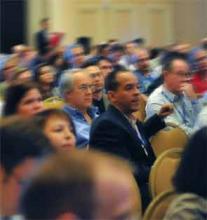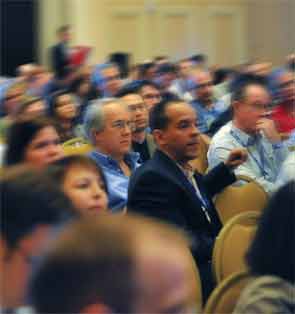User login
If only there were a place where young hospitalists, mid-career hospitalists, and veteran hospitalists in a new position could go to proverbially pick the brains of those who came before them in an informal setting that practically begs for crowd-sourced learning.
Wait, there is.
Sure, the roughly 3,000 hospitalists who descend upon SHM’s annual meeting at Mandalay Bay Resort and Casino will be there for HM14’s slate of educational offerings, keynote addresses, and clinical updates. But for guys like Darren Swenson, MD, a regional medical advisor for IPC The Hospitalist Co. in Las Vegas, it’s also a chance to catch up with long-lost colleagues and med-school buddies while making new friends and gleaning tips from a who’s who of industry leaders.
“Whether you’re early in your career, or eight, 10, 12 years into your career, healthcare is changing so rapidly now, getting access to leadership skills is essential,” he says.
HM14 course director Daniel Brotman, MD, FACP, SFHM, says it’s impossible to overstate the value of networking at the annual meeting.
“Many of these folks I see once a year, and I look forward to seeing them,” says Dr. Brotman, who practices at John Hopkins Hospital in Baltimore, Md. “For me, as a director of a hospitalist program, to network with other people who direct programs and are trying to navigate very similar challenges is great, because it gives me ideas for how I might do something different, and I can return the favor.”
There’s the flipside, too, where commiseration helps soothe the soul. But mostly, conversations with other physicians who struggle the same issues that you see can be the meeting’s most important takeaway.
“There’s so much commonality in what we’re dealing with on a day-to-day basis to run a hospitalist program successfully,” Dr. Brotman adds. “Ultimately, good ideas are good ideas.
–HM14 course director Daniel Brotman, MD, FACP, SFHM
“There is so much innovation going on in this field that’s it’s almost impossible not to attend this meeting and come away with so many new ideas.”
In particular, Dr. Brotman sees great opportunities for early-career hospitalists to meet, greet, and build relationships.
“One of the things that marks our specialty is recognizing that the future of hospital medicine is the young hospitalists who are attending these meetings and getting fired up about it,” he adds.
SHM President Eric Howell, MD, SFHM, chief of hospital medicine at Johns Hopkins Bayview Medical Center in Baltimore, sees another, less heralded benefit to networking: pride.
“You can really brag about your program’s success and your individual successes,” he says. “That can’t be underestimated in terms of value.”
Dr. Howell encourages junior faculty to attend in order to meet and interact with as many people as possible, through the poster contests or impromptu post-meeting beverages. Such discussion, whether it involves bragging or the aforementioned commiserating, tends to invigorate and energize staffers, he says.
“It’s therapeutic to be able to discuss these things,” Dr. Howell adds. “Networking is also peer-to-peer mentoring. You can tell them things you can’t tell your boss or the people you oversee. It allows you a fairly open conversation with a peer on how to advance your program and your career.”
Richard Quinn is a freelance writer in New Jersey.
If only there were a place where young hospitalists, mid-career hospitalists, and veteran hospitalists in a new position could go to proverbially pick the brains of those who came before them in an informal setting that practically begs for crowd-sourced learning.
Wait, there is.
Sure, the roughly 3,000 hospitalists who descend upon SHM’s annual meeting at Mandalay Bay Resort and Casino will be there for HM14’s slate of educational offerings, keynote addresses, and clinical updates. But for guys like Darren Swenson, MD, a regional medical advisor for IPC The Hospitalist Co. in Las Vegas, it’s also a chance to catch up with long-lost colleagues and med-school buddies while making new friends and gleaning tips from a who’s who of industry leaders.
“Whether you’re early in your career, or eight, 10, 12 years into your career, healthcare is changing so rapidly now, getting access to leadership skills is essential,” he says.
HM14 course director Daniel Brotman, MD, FACP, SFHM, says it’s impossible to overstate the value of networking at the annual meeting.
“Many of these folks I see once a year, and I look forward to seeing them,” says Dr. Brotman, who practices at John Hopkins Hospital in Baltimore, Md. “For me, as a director of a hospitalist program, to network with other people who direct programs and are trying to navigate very similar challenges is great, because it gives me ideas for how I might do something different, and I can return the favor.”
There’s the flipside, too, where commiseration helps soothe the soul. But mostly, conversations with other physicians who struggle the same issues that you see can be the meeting’s most important takeaway.
“There’s so much commonality in what we’re dealing with on a day-to-day basis to run a hospitalist program successfully,” Dr. Brotman adds. “Ultimately, good ideas are good ideas.
–HM14 course director Daniel Brotman, MD, FACP, SFHM
“There is so much innovation going on in this field that’s it’s almost impossible not to attend this meeting and come away with so many new ideas.”
In particular, Dr. Brotman sees great opportunities for early-career hospitalists to meet, greet, and build relationships.
“One of the things that marks our specialty is recognizing that the future of hospital medicine is the young hospitalists who are attending these meetings and getting fired up about it,” he adds.
SHM President Eric Howell, MD, SFHM, chief of hospital medicine at Johns Hopkins Bayview Medical Center in Baltimore, sees another, less heralded benefit to networking: pride.
“You can really brag about your program’s success and your individual successes,” he says. “That can’t be underestimated in terms of value.”
Dr. Howell encourages junior faculty to attend in order to meet and interact with as many people as possible, through the poster contests or impromptu post-meeting beverages. Such discussion, whether it involves bragging or the aforementioned commiserating, tends to invigorate and energize staffers, he says.
“It’s therapeutic to be able to discuss these things,” Dr. Howell adds. “Networking is also peer-to-peer mentoring. You can tell them things you can’t tell your boss or the people you oversee. It allows you a fairly open conversation with a peer on how to advance your program and your career.”
Richard Quinn is a freelance writer in New Jersey.
If only there were a place where young hospitalists, mid-career hospitalists, and veteran hospitalists in a new position could go to proverbially pick the brains of those who came before them in an informal setting that practically begs for crowd-sourced learning.
Wait, there is.
Sure, the roughly 3,000 hospitalists who descend upon SHM’s annual meeting at Mandalay Bay Resort and Casino will be there for HM14’s slate of educational offerings, keynote addresses, and clinical updates. But for guys like Darren Swenson, MD, a regional medical advisor for IPC The Hospitalist Co. in Las Vegas, it’s also a chance to catch up with long-lost colleagues and med-school buddies while making new friends and gleaning tips from a who’s who of industry leaders.
“Whether you’re early in your career, or eight, 10, 12 years into your career, healthcare is changing so rapidly now, getting access to leadership skills is essential,” he says.
HM14 course director Daniel Brotman, MD, FACP, SFHM, says it’s impossible to overstate the value of networking at the annual meeting.
“Many of these folks I see once a year, and I look forward to seeing them,” says Dr. Brotman, who practices at John Hopkins Hospital in Baltimore, Md. “For me, as a director of a hospitalist program, to network with other people who direct programs and are trying to navigate very similar challenges is great, because it gives me ideas for how I might do something different, and I can return the favor.”
There’s the flipside, too, where commiseration helps soothe the soul. But mostly, conversations with other physicians who struggle the same issues that you see can be the meeting’s most important takeaway.
“There’s so much commonality in what we’re dealing with on a day-to-day basis to run a hospitalist program successfully,” Dr. Brotman adds. “Ultimately, good ideas are good ideas.
–HM14 course director Daniel Brotman, MD, FACP, SFHM
“There is so much innovation going on in this field that’s it’s almost impossible not to attend this meeting and come away with so many new ideas.”
In particular, Dr. Brotman sees great opportunities for early-career hospitalists to meet, greet, and build relationships.
“One of the things that marks our specialty is recognizing that the future of hospital medicine is the young hospitalists who are attending these meetings and getting fired up about it,” he adds.
SHM President Eric Howell, MD, SFHM, chief of hospital medicine at Johns Hopkins Bayview Medical Center in Baltimore, sees another, less heralded benefit to networking: pride.
“You can really brag about your program’s success and your individual successes,” he says. “That can’t be underestimated in terms of value.”
Dr. Howell encourages junior faculty to attend in order to meet and interact with as many people as possible, through the poster contests or impromptu post-meeting beverages. Such discussion, whether it involves bragging or the aforementioned commiserating, tends to invigorate and energize staffers, he says.
“It’s therapeutic to be able to discuss these things,” Dr. Howell adds. “Networking is also peer-to-peer mentoring. You can tell them things you can’t tell your boss or the people you oversee. It allows you a fairly open conversation with a peer on how to advance your program and your career.”
Richard Quinn is a freelance writer in New Jersey.



